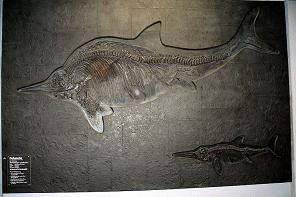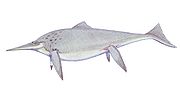|
They were
particularly abundant in the Jurassic Period, until
they were replaced as the top aquatic predators by
plesiosaurs in the
Cretaceous Period. They
belong to the order known as
Ichthyosauria
or Ichthyopterygia
('fish flippers' - a designation introduced by Sir
Richard Owen in 1840,
although the term is now used more for the parent
clade of the
Ichthyosauria).
Description
Ichthyosaurs averaged two to four metres in length (although a few were
smaller, and some species grew much larger), with a porpoise-like
head and a long, toothed snout. Built for speed, like modern
tuna, some
ichthyosaurs appear also to have been deep divers, like some modern whales (Motani,
2000). It has been estimated that ichthyosaurs could swim at speeds up to
40 km/h (25 mph).
Similar to modern
cetaceans
such as whales and dolphins, they were air-breathing and also were
viviparous
(some adult fossils have even been found containing
fetuses). Although they were reptiles and descended from egg-laying
ancestors, viviparity is not as unexpected as it first appears. All
air-breathing marine creatures must either come ashore to lay
eggs, like
turtles and some
sea
snakes, or else give birth to live young in surface waters, like whales
and dolphins. Given their
streamlined bodies, heavily adapted for fast swimming, it would have
been difficult for ichthyosaurs to scramble successfully onto land to lay
eggs.
According to weight estimates by Ryosuke Motani
a 2.4 meter (8 ft)
Stenopterygius weighed around 163 to 168 kg (360 to 370 lb), whilst
a 4.0-meter (13 ft)
Ophthalmosaurus icenicus weighed 930 to 950 kg (about a ton).
Although ichthyosaurs looked like fish, they were not.
The earliest reconstructions of ichthyosaurs omitted the dorsal
fin, which had no hard skeletal structure, until finely-preserved specimens
recovered in the 1890s from the
Holzmaden
lagerstätten in
Germany
revealed traces of the fin. Unique conditions permitted the preservation of
soft tissue impressions.
Ichthyosaurs had fin-like limbs, which were possibly used for
stabilization and directional control, rather than propulsion, which would
have come from the large shark-like tail. The tail was bi-lobed, with the
lower lobe being supported by the caudal vertebral column, which was
"kinked" ventrally to follow the contours of the ventral lobe.
Apart from the obvious similarities to fish, the ichthyosaurs also shared
parallel developmental features with dolphins,
lamnid sharks, and tunas. This gave them a broadly similar appearance,
possibly implied similar activity levels (including thermoregulation), and
presumably placed them broadly in a similar ecological niche.
For their food, many of the fish-shaped ichthyosaurs relied heavily on
ancient
cephalopod kin of
squids called
belemnites. Some early ichthyosaurs had teeth adapted for crushing
shellfish.
They also most likely fed on fish, and a few of the larger species had heavy
jaws and teeth that indicated they fed on smaller reptiles. Ichthyosaurs
ranged so widely in size, and survived for so long, that they are likely to
have had a wide range of prey. Typical ichthyosaurs have very large eyes,
protected within a
bony ring, suggesting that they may have hunted at night
History of Discoveries
The genus had first been described in
1699 from fossil fragments discovered in Wales.
The first fossil
vertebrae were published twice in 1708 as
tangible mementos of the
Universal Deluge. The
first complete ichthyosaur fossil was found in 1811 by
Mary
Anning in
Lyme
Regis, along what is now called the
Jurassic Coast. She subsequently discovered
three separate species.
In 1905, the
Saurian Expedition led
by
John C. Merriam of the
University of California
and financed by
Annie Alexander, found
25 specimens in central Nevada,
which during the Triassic was under a shallow ocean. Several of the
specimens are now in the collection of the University of California
Museum of Paleontology. Other specimens are embedded in the rock and visible
at
Berlin–Ichthyosaur State Park
in Nye County. In 1977,
the Triassic ichthyosaur Shonisaurus became the
State Fossil of Nevada.
Nevada is the only state to possess a complete skeleton, 55 ft (17 m) of
this extinct marine reptile. In 1992, Canadian ichthyologist Dr. Elizabeth Nicholls
(Curator of Marine Reptiles at the Royal Tyrrell Museum) uncovered the
largest fossil specimen ever, a 23 m-long (75 ft) example.
History
The
earliest ichthyosaurs, looking more like finned lizards than the
familiar fish or dolphin
forms, are known from the Early and Early-Middle (Olenekian
and Anisian)
Triassic
strata of
Canada, China,
Japan, and
Spitsbergen in
Norway.
These primitive forms included the genera
Chaohusaurus,
Grippia,
and
Utatsusaurus.
These very early proto-ichthyosaurs, which are now
classified as
Ichthyopterygia rather than as ichthyosaurs proper, quickly gave rise to true ichthyosaurs sometime around the
boundary between the Early Triassic and Middle Triassic. These later
diversified into a variety of forms, including the sea
serpent like
Cymbospondylus, which reached 10 meters, and smaller more typical
forms like
Mixosaurus. By the
Late Triassic, ichthyosaurs consisted of both classic Shastasauria and
more advanced, "dolphin"-like Euichthyosauria (Californosaurus,
Toretocnemus) and Parvipelvia (Hudsonelpidia,
Macgowania).
Experts disagree over whether these represent an evolutionary continuum,
with the less specialised shastosaurs a
paraphyletic grade that was evolving into the more advanced forms, or whether the two were separate
clades that
evolved from a common ancestor earlier on.
During the
Carnian
and Norian,
shastosaurs reached huge sizes.
Shonisaurus popularis, known from a number of specimens from the
Carnian of Nevada, was 15 meters long. Norian shonisaurs are known from both
sides of the Pacific. Himalayasaurus tibetensis and
Tibetosaurus
(probably a synonym) have been found in
Tibet. These
large (10 to 15 meters long) ichthyosaurs probably belong to the same genus
as Shonisaurus. While the gigantic
Shonisaurus sikanniensis, whose
remains were found in the Pardonet formation of British Columbia by
Elizabeth Nicholls, reached as much as 21 meters in length - the largest
marine reptile known to date.
These giants (along with their smaller cousins) seemed to
have disappeared at the end of the Norian. Rhaetian
(latest Triassic) ichthyosaurs are known from England, and these are very
similar to those of the
Early Jurassic. Like the dinosaurs, the ichthyosaurs and their
contemporaries the plesiosaurs survived the end-Triassic extinction event,
and immediately diversified to fill the vacant ecological niches of the
earliest Jurassic.
The Early Jurassic, like the Late Triassic, was the heyday
of the ichthyosaurs, which are
|

|
|
Ichthyosaurus sp. fossil (click picture for larger image)
(Picture
Source)
|
represented by four families and a variety of
species, ranging from one to ten meters in length. Genera include
Eurhinosaurus,
Ichthyosaurus,
Leptonectes,
Stenopterygius, and the large predator
Temnodontosaurus, along with the persistently primitive
Suevoleviathan, which was little changed from its Norian ancestors. All
these animals were streamlined, dolphin-like forms, although the more
primitive animals were perhaps more elongated than the advanced and compact
Stenopterygius and
Ichthyosaurus.
Ichthyosaurs were still common in the
Middle Jurassic, but had now decreased in diversity. All belonged to the
single clade Ophthalmosauria. Represented by the 4 meter long
Ophthalmosaurus and related genera, they were very similar to
Ichthyosaurus, and had attained a perfect "tear-drop" streamlined form.
The eyes of Ophthalmosaurus were huge, and it is likely that these
animals hunted in dim and deep water.
Ichthyosaurs seemed to decrease in diversity even further
with the
Cretaceous. Only three genera are known,
Caypullisaurus, Maiaspondylus, and
Platypterygius, although they had a worldwide distribution. This
last ichthyosaur genus became extinct during the
Cenomanian-Turonian extinction event early in the Late Cretaceous (as
did the
pliosaurs). Interestingly, less hydrodynamically efficient animals like
mosasaurs
and long-necked
plesiosaurs flourished. It could be that the ichthyosaurian over-specialisation
was a contributing factor to their extinction, possibly being unable to
'keep up' with the fast swimming and highly evasive new
teleost
fish, which had become dominant at this time, against which the sit-and-wait
ambush strategies of the mosasaurs proved superior.
End of Reading

Return to the
Old Earth Ministries Online Earth
History Curriculum homepage.

Source Page:
Ichthyosaur
|





